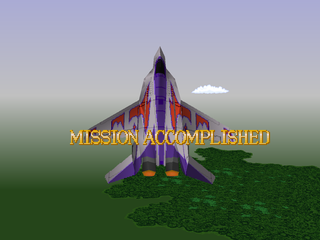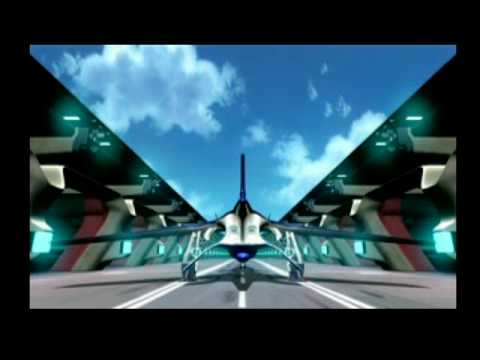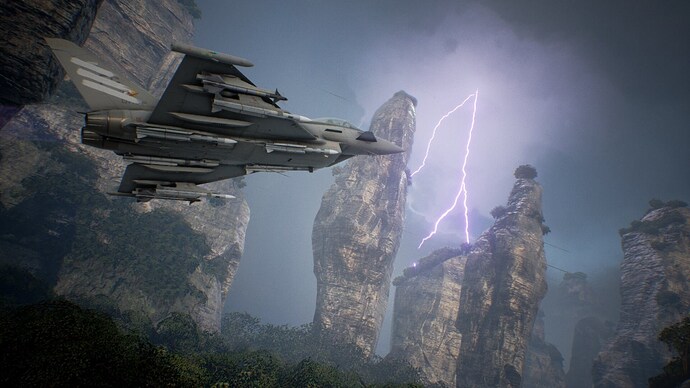29 days ago, I had played zero Ace Combat games. As of Saturday, I’ve played six of ’em! And what a month it’s been! I wrote short reviewish notes on each one (and then a g.d. essay on the latest release) over on Backloggd, but I might as well elaborate and backlink here, why not?
As a preface, I went through and at least tried playing the mainline games in order of release, starting with Air Combat and ending with Ace Combat 7, and wow am I glad to have done it that way. The emotional payoff of going from the PS1 games to the genuinely beautiful refinement of 2019’s AC7 was crucial to this whole thing. I big-time recommend it to anyone else, even if you skip around instead — playing AC3, then 5 and 7, I’d suggest, as a little buffet appetizer tasting menu of the evolution of Ace Combat.
Now, on to the show:
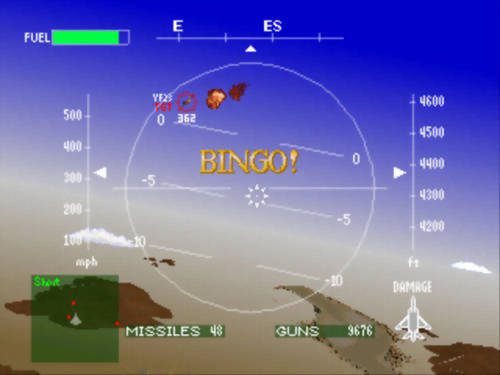
I was partway through my second playthrough of Armored Core VI and midway through a Gran Turismo 2 run when I thought to myself: “I like fusing with machines. I bet that other AC series has got it goin’ on!”
So I kicked things off with Air Combat, but didn’t get further than three levels in before moving on the very same day to AC2. Actually, Air Combat was my bookend to this experience, since I came back to it after finishing Ace Combat 7 this past weekend — but again I didn’t bother beating the fifth mission even.
It has some stuff going for it: the way the sky ahead of you dithers from periwinkle to emerald, the world map that contextualizes your sense of place and mission very strongly. (Much better, IMO, than the monochromatic wireframes of the PS2 era and even AC7.) The way that, when you crash, you lose your plane and gotta buy it back. That’s a wicked mechanic they should have carried forward!
But God Damn does that game feel so stiff and yucky. Jousting is suicide: You can’t quickly dive in order to jink an enemy missiles whatsoever. Turning is slippery in the least comfortable way, and the Top Gun-ass cowboy radio voice lines grated on me harshlike. But hey! At least it has a really slick logo. And, it set the stage for all these superb sequels, so I can’t be too mad.
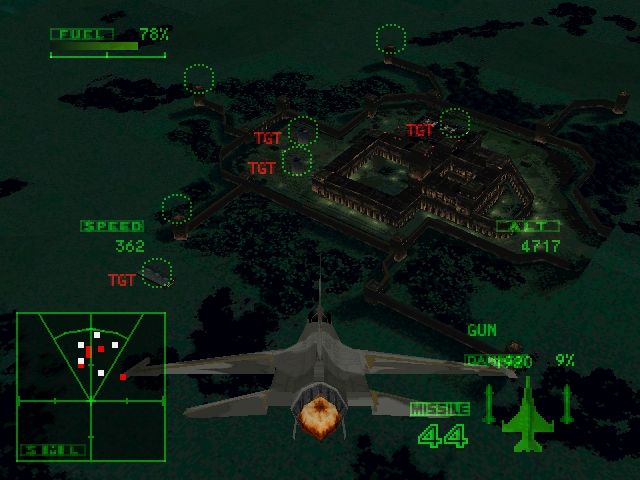
I booted up Ace Combat 2 and finished the whole thing, like, two days later. Now that is some fun arcade flying. It’s funny how much a visual upgrade the planes and terrain received in the two years since Air Combat. Namco music carried me over those skyscrapers and mountain ranges, and it’s hard to describe but I also don’t want to understate this: The soundtrack carried me through this game. It evokes Top Gun when it’s time to dogfight, then gets electronic and bouncy other times; they turn up the clanking industrial, brooding atmosphere when that’s the vibe, or lounge into a chair for some synthy brass magic. It feels real cool to fly to these tunes.
As for the gameplay, mission design was a winner in this’n. I thought it was very exciting to have altitude restrictions in certain missions, like the flight through a canyon. Little did I know that would set the tone for setpieces for the rest of the series! Same of course goes for that tunnel run at the end.
The mission briefings were informative and interesting, and I appreciate that you can advance the text without interrupting the dialogue — a feature of pretty much all the games I played except for the latest and mostly greatest AC7! What a weird step back that is.
I liked that I could choose a wingman for some missions, though the choice felt pretty much fake — they acted pretty much the same, which is to say useless. But, looking back, what a nice way to softlaunch recurring character Kei Nagase into the series.
The game’s scope is relatively reigned in and that’s as negative as I can get on this game. I haven’t gone back to compare it to the rest of the ACs, or to go through the “Operation A” set of missions instead of the “Operation B” ones I ended up on — yes, there is a branch in the game’s path, if only for a stretch in the middle! But that’s OK by me. I had a good time, and the short length of this game was a strength in my eyes, since by the time I finished I already knew that I wanted to play as many ACs as I could.
I went in to Ace Combat 3: Electrosphere knowing already, thanks to Sean Seanson’s enjoyable rundown of all PS1 Namco games, to seek out an English patch to the Japanese release. So glad that I did, too, and huge thanks to the team who put the hard work in so that I and others can play this great game.
I only went through it once, so there are many missions and plot beats that I missed out on! This is the Ace Combat I most want to revisit. In this way, I set myself up for success, because I used new save slots after making a decision in a mission.
This game is great. The presentation and atmosphere are superb. Love a slick menu. And the animation used in the cutscenes is so good. I could immediately tell that it was done by the studio behind Ghost in the Shell. The commercial and news messaging between comms from military folk is such a great touch, in terms of storytelling. The novelty and uniqueness is so compelling that I can forgive them for being a tad lengthy at times, especially when I just wanted to get back in the saddle.
Project Aces reconfigured the handling of aircraft in this game. These machines are heavy and weighty, and flying is more about controlling momentum and influencing inertia than it ever was. It takes getting used to, but when you have it down, it’s a great feeling. And you will have some close calls, diving straight toward the ground and pitching up to level out — only to realize, you’re still heading downward for a fair bit longer than you meant to be!
The conversation between characters mid-mission is such a great addition to the series, really drew me in. And the game incorporates impactful decisions mid-mission in a very organic way. Your actions will branch the campaign in wildly different directions at several points throughout: Should you defect at the end of a mission? Leave your crew and follow this ace into the unknown? Betray a squadmate on mission command’s orders?It is SO insanely good. I wish they had more of this in future AC games. The fact they went so huge on the scope and drama, heightening the intrigue and involvement at every level, was a phenomenal choice on Project Aces’ part.
It also means you might have a kinda lame experience, like I did for sticking with the peacekeeping internationalist group UPEO throughout the game. I stopped a coup, I blew up the junta general as he tried to escape by helicopter, whoop-dee-doo — what I really did was slide past many the interesting kinks and character moments! But the promise was there, and one of the decisions I had to make to stand with UPEO side really positioned my character as something of a disloyal coward, and I have to say its ability to make you feel craven for playing craven is pretty cool on its own.
In case anyone reading doesn’t know, the version released in Europe and North America was heavily stripped back. It was made to fit on one disc, so they changed up the story in a big ugly way, dropped the cutscenes, ditched the branching paths (I think) and just really gutted it up. I’m not gonna judge whether or not they should have ported the thing wholesale as it was in Japan, or whether paring it back was a smart business decision. I just don’t know, and these days I can enjoy a translated version of the original release very easily, so it seems unnecessarily discursive to wax about that.
All I can say is that I am very glad they made it this way and that I get to play it now. If there is a single “Old Ace Combat” everyone here should play, this is it. And it is definitely the most Insert Credit of, I would say, any of the games, period. Check This Stuff Out.
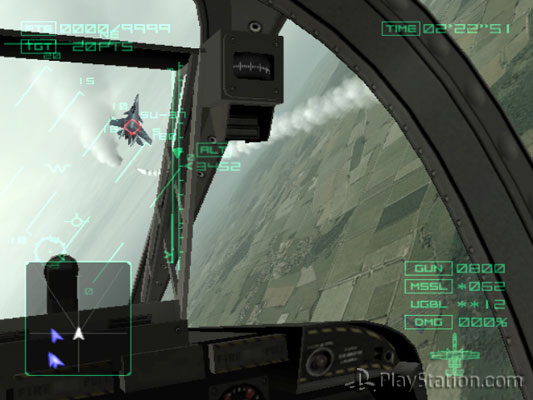
Ace Combat 4, what a jump. Big leaps forward in terms of gameplay and feel, and apparently it was the best-selling of the whole series until AC7 unseated it in 2019. Makes sense, because if I were the owner of a brand-spankin’-new PS2 and I had this to play, I’d be singing its praises day and night. This is the standard-bearer for how modern Ace Combat gameplay feels, even through the latest entry.
I’ll focus on the narrative in a bit, but I wanted to briefly mention some improvements in the gameplay. For one, it’s nice to have the option to buy not only new aircraft, a staple for the series, but also special weapons to tailor them to different kinds of air-to-air or air-to-surface operations. It’s just a nice touch to have an extra layer of upgrades.
Also, AC4 allows you to leave the combat zone at any time so you can return to a base or carrier, land, repair the plane and load up with a full bay of missiles and bombs. It’s a player-friendly addition, but a sorta ridiculous one in that there is no penalty whatsoever to doing it, not even a time penalty. You can bail on a dogfight or bombing run with 3 mins on the clock when you cross the boundary line, and high-tail it to base and back without screwing yourself over. Kiiinda feels cheap to exploit, in an Unfun way.
My favorite thing this game did, though, is introduce a new view mode. You could always play in third-person, or in a HUD-only first-person perspective, where it’s as if your eyes are on the nose of the plane. But here you can sit in the cockpit, and each plane’s interior is different from the others’, and you still get the HUD over the window you’re looking through. You can look behind you and side-to-side, but it’s as if you’re constrained to how far back you can crane your neck. The reality of your vehicle gets in the way of your desire to see directly behind you. It’s just my favorite way to play. Sometimes, when I can tell I’m going to be flying right by an exploding bandit, I’ll swap over to third person just for the cinematic angle, like watching a highlight reel.
Alright, so, the big topic is where this next generation of Ace Combat games would go after Electrosphere went deep on the cyberpunk sci-fi themes. Well… AC4 represents a hesitation or at least a moment of restraint for the series. Project Aces stepped back from producing the bleeding edge of twisty, winding narratives in action flight games in favor of a tighter experience that branches not one iota from its rails. I think it wasn’t a bad decision, and in the case of this game’s narrative in particular, I think it was smart to go for a more controlled story experience instead of a more visionary one.
AC3 is where the series really made itself into a platform for getting philosophical on politics. And that was cool, it was a game about a nationless world that hung in the balance between corporations and NGOs, a concept Project Aces would revisit in AC Zero especially. Very Metal Gear.
In AC4, we got something arguably even more Metal Gear than that: The quintessential, outwardly anti-war war game. Sure, you are blasting bandits from the sky and dropping bombs on ground targets, one very efficient cog in a war machine with a righteous and defensive mission. But between every couple levels is a slideshow of illustrations narrated by a man who grew up in occupied territory. He knew the ace who serves as your recurring nemesis personally, as he was indirectly responsible for the death of the boy’s family.
His perspective inflects the action with a melancholy tone, a through-line that wavers between solemn, passionless, understatedly poetic, but does not come attached with melodramatic notes and larger-than-life cartoonishness. It’s a surprising and tasteful treatment of war.
It’s not perfect. In-game, squadmates chat you up and you’re often given the chance to respond, but never offered a choice beyond YES or NO. Sometimes they ask you open-ended questions, or phrase the question in a negative manner, so a simple YES/NO ends up being the dimmest possible reply. It’s a far cry from the interactive choices you could make in AC3. But it’s something, and that’s at least usually fun.
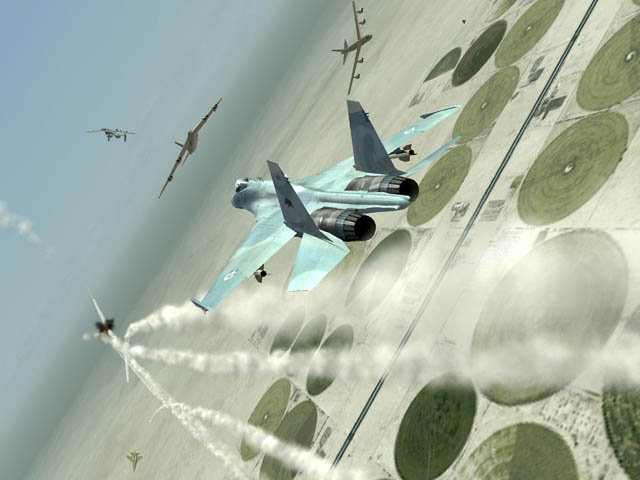
Ace Combat 5 was a nice, if conservative, iteration on the series. It held on to the gameplay changes I enjoyed most in AC4, dropped a good one for unclear reasons, and got a little more personal with its narrative, dropping the pensive melancholy for something more cinematic. It’s worth playing.
AC4 presented the remembrances of one man, narrated over still imagery. AC5 drops the illustrations and instead delivers prerendered CG cutscenes, focusing primarily on a small gaggle of pilots to care about. It throws in a wise mentor figure for good measure and, presto, we have traded some of the vibe-heavy storytelling in favor of a clearer picture: Characters Doing Stuff.
The stuff they do is pretty sick, too. A wingman has to abandon her craft, so you have to find her before the enemy does. Another nation’s president needs an escort from would-be assassins. There’s a coup of sorts and your renowned, feared squadron is targeted — so you escape in dinky training planes with no weapons and make it out of there by the skin of your teeth and the good grace of skillful flying. It’s cool, and it’s very well paced.
That’s especially important because this is the longest of the series by a decent margin, and even the next game, Ace Combat Zero, would pare back the campaign length. If I had one suggestion, it would have been to reduce how many ground-target missions were featured in this game. It just isn’t as exciting, conceptually, to bomb stuff on the ground than it is to engage in dynamic aerial battles with nimble opponents.
The narrative also gestures at the history of its world in a way that is more intriguing, more suggestive of a checkered history and storied series of conflicts than previous games got into. Almost like they knew they could follow this one up with a prequel…
So, I liked it, though AC5 is just inches “better” than AC4 was. Wish I still had the ability to fly back to the carrier for a resupply, though. Some of these missions make it very easy to run out of munitions!
One last gripe: You, squadron leader, choose not only your own plane but also the planes your squadmates will take to the skies as well. This sounds cooler than it really is. Honestly, the difference doesn’t matter that much — sometimes your squadmates accomplish objectives or shoot down craft, unlike the previous title where they are pretty useless, but I couldn’t confidently say the choice of plane mattered terribly. And since you have to pay for each plane, this becomes a chore and an errand, which… I just didn’t particularly love.
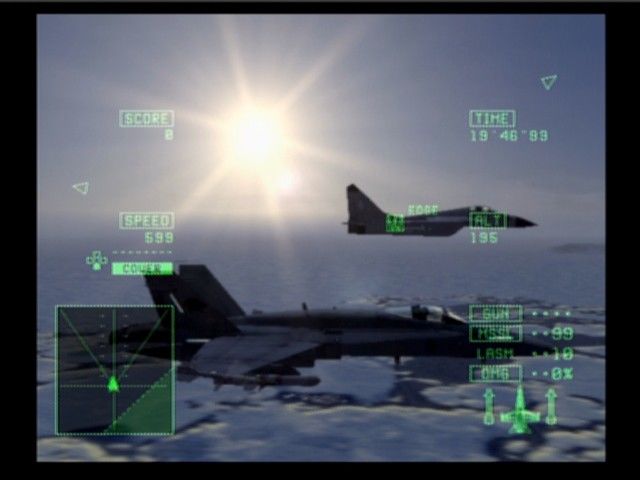
Air Combat Zero has the greatest gameplay of this PS2 era, easily. I blazed through it and had a great time, even though I was playing on Hard mode for the first time — a choice I never regretted but one I could definitely tell was slowing me down. I S-ranked all but two of the missions on my playthrough, so something was really working. The tension was heightened in every dogfight, the score requirements in certain missions were pushed near near my limits, I just had a load of fun.
And the game finally puts a deserved emphasis on fighting packs of aces, which is just so good and such a logical objective for this series. Enemy pilots get a name and logo for their group, they get an in-level cutscene, they are fearsome and they put up a meaningful fight. It’s exciting stuff. This, combined with the shorter overall length of the game, means this game is the most densely high-quality Ace Combat in the series to date.
So, playing ACZ great. But the narrative here really suffers in the light of AC4 and AC5. Project Aces eschewed all interest in a character-driven plot in favor of lore, and I just can’t dig that. Don’t let the live-action FMV cutscenes fool you, there’s just one character in this game, and he disappears for the middle act. Things happen, but it feels like nobody does them. It’s so weird. Especially because this is the game that brings anarchism into focus as a meaningful political ideology, though a caricatured version shared only by the bad guys, who want to create A World With No Borders. The idea just needed more room to breathe.
It’s wrapped in a good narrative frame, though. The FMVs are portions of a documentary being filmed to investigate the identity of the mysterious jet pilot who turned the tide of war and saved the world — the player of course — then vanished without a trace. I like that! It just needed… more!
I’ll end on a generous note. These games are so much about finding yourself in the skies. And this game turns this into a mechanical system. ACZ allows you to say, I am an honorable pilot, or I am a merciless mercenary. The morality system here bakes a new degree of self-expression into the mechanics, and the game notices, reacts to your disposition in enemy radio chatter and the FMVs — that’s the good stuff. You express and also find yourself in these behaviors. Indulging your bloodthirst pays well. Is it worth it? Are the enemy’s lives, their societal infrastructure, worthy of your consideration? Or is it more important to destroy even the neutral targets if it means you might get a better plane quicker?
I skipped Ace Combat 6, because I don’t have an Xbox 360 and don’t know about emulating it. I hear it’s so-so. Maybe I’ll find out for myself sometime!
Ace Combat 7 is seriously contending for my favorite game I’ve played this year. To experience it after all the rest was so amazing. I have so much to say about it, but I’ve already said so much here, so I’m copping out. I’ll just going to link my long, detailed Backloggd review and call it here.
I really want to express how awesome it was to see the latest and greatest game after running through the PS1 and PS2 titles. The emotional high was crazy. Of course I’m speedrunning “lifelong fan” status, so my peaks are lower and the valleys shallower than if I had actually stewed on each of these games for months or years, replaying them, playing the Arcade and Multiplayer modes and so forth. But it’s just so good. I couldn’t keep from running through them all. And I’m feeling so satisfied now.
If you read all this, wow thanks! Lemme know what you thought! I hope others here check these crazy, weird and fun games out. And if anything I said inspires you to dive in from the beginning, too, then I’d call it…
